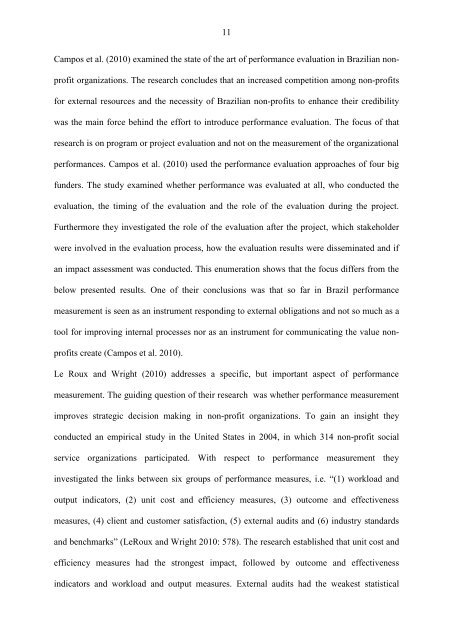Strategic responses to Performance Measurement in Nonprofit ...
Strategic responses to Performance Measurement in Nonprofit ...
Strategic responses to Performance Measurement in Nonprofit ...
You also want an ePaper? Increase the reach of your titles
YUMPU automatically turns print PDFs into web optimized ePapers that Google loves.
11<br />
Campos et al. (2010) exam<strong>in</strong>ed the state of the art of performance evaluation <strong>in</strong> Brazilian non-<br />
profit organizations. The research concludes that an <strong>in</strong>creased competition among non-profits<br />
for external resources and the necessity of Brazilian non-profits <strong>to</strong> enhance their credibility<br />
was the ma<strong>in</strong> force beh<strong>in</strong>d the effort <strong>to</strong> <strong>in</strong>troduce performance evaluation. The focus of that<br />
research is on program or project evaluation and not on the measurement of the organizational<br />
performances. Campos et al. (2010) used the performance evaluation approaches of four big<br />
funders. The study exam<strong>in</strong>ed whether performance was evaluated at all, who conducted the<br />
evaluation, the tim<strong>in</strong>g of the evaluation and the role of the evaluation dur<strong>in</strong>g the project.<br />
Furthermore they <strong>in</strong>vestigated the role of the evaluation after the project, which stakeholder<br />
were <strong>in</strong>volved <strong>in</strong> the evaluation process, how the evaluation results were dissem<strong>in</strong>ated and if<br />
an impact assessment was conducted. This enumeration shows that the focus differs from the<br />
below presented results. One of their conclusions was that so far <strong>in</strong> Brazil performance<br />
measurement is seen as an <strong>in</strong>strument respond<strong>in</strong>g <strong>to</strong> external obligations and not so much as a<br />
<strong>to</strong>ol for improv<strong>in</strong>g <strong>in</strong>ternal processes nor as an <strong>in</strong>strument for communicat<strong>in</strong>g the value non-<br />
profits create (Campos et al. 2010).<br />
Le Roux and Wright (2010) addresses a specific, but important aspect of performance<br />
measurement. The guid<strong>in</strong>g question of their research was whether performance measurement<br />
improves strategic decision mak<strong>in</strong>g <strong>in</strong> non-profit organizations. To ga<strong>in</strong> an <strong>in</strong>sight they<br />
conducted an empirical study <strong>in</strong> the United States <strong>in</strong> 2004, <strong>in</strong> which 314 non-profit social<br />
service organizations participated. With respect <strong>to</strong> performance measurement they<br />
<strong>in</strong>vestigated the l<strong>in</strong>ks between six groups of performance measures, i.e. “(1) workload and<br />
output <strong>in</strong>dica<strong>to</strong>rs, (2) unit cost and efficiency measures, (3) outcome and effectiveness<br />
measures, (4) client and cus<strong>to</strong>mer satisfaction, (5) external audits and (6) <strong>in</strong>dustry standards<br />
and benchmarks” (LeRoux and Wright 2010: 578). The research established that unit cost and<br />
efficiency measures had the strongest impact, followed by outcome and effectiveness<br />
<strong>in</strong>dica<strong>to</strong>rs and workload and output measures. External audits had the weakest statistical
















